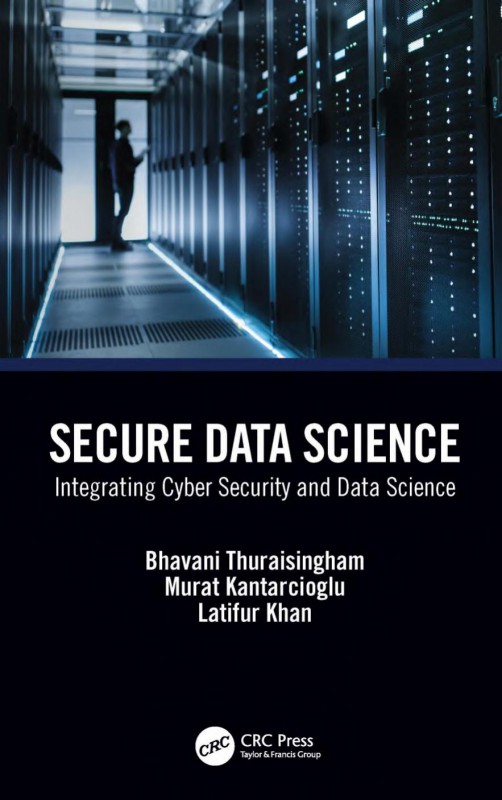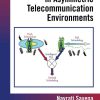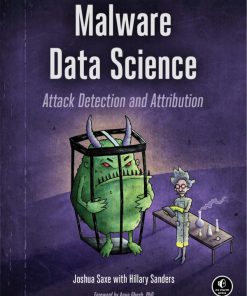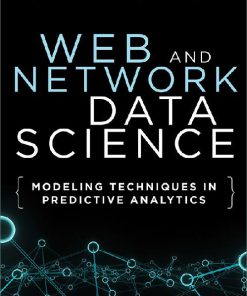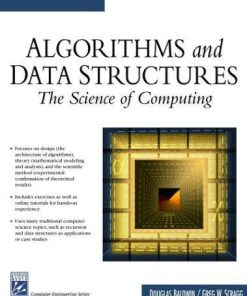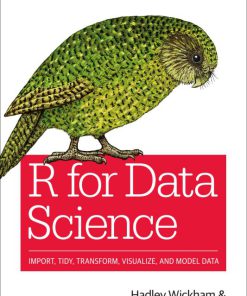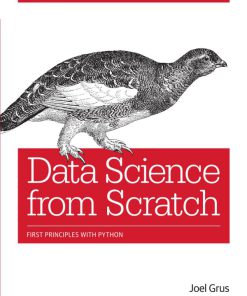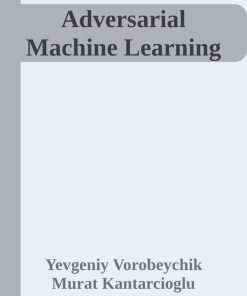Secure data science intergrating cyber security and data science 1st Edition by Bhavani Thuraisngham, Murat Kantarcioglu, Latifur Khan ISBN 9781000557510 1000557510
$50.00 Original price was: $50.00.$25.00Current price is: $25.00.
Authors:Thuraisingham, Bhavani; Kantarcioglu, Murat; Khan, Latifur , Series:Cyber Security [390] , Tags:Data Science; Data Security; Big data; Cybersecurity , Author sort:Thuraisingham, Bhavani & Kantarcioglu, Murat & Khan, Latifur , Ids:DOI , Languages:Languages:eng , Published:Published:Mar 2022 , Publisher:CRC Press , Comments:Comments:Secure Data Science
Secure data science intergrating cyber security and data science 1st Edition by Bhavani Thuraisngham, Murat Kantarcioglu, Latifur Khan – Ebook PDF Instant Download/Delivery. 9781000557510 ,1000557510
Full download Secure data science intergrating cyber security and data science 1st Edition after payment
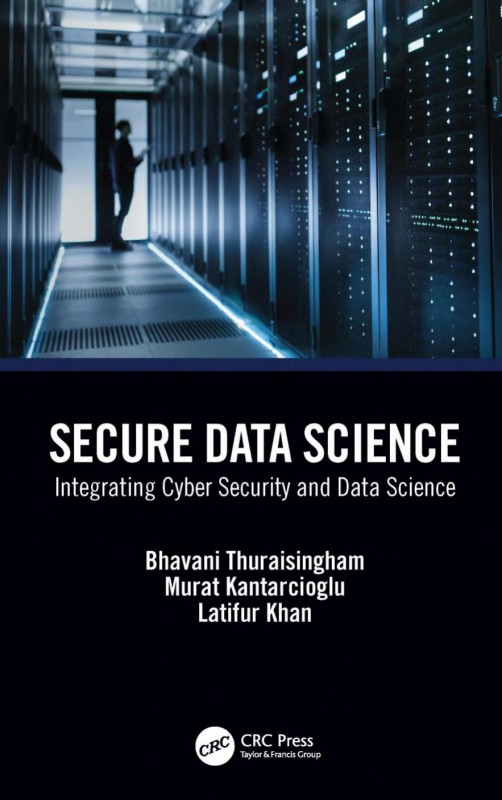
Product details:
ISBN 10: 1000557510
ISBN 13: 9781000557510
Author: Bhavani Thuraisngham, Murat Kantarcioglu, Latifur Khan
Secure data science intergrating cyber security and data science 1st Edition Table of contents:
Chapter 1 Introduction
1.1 Overview
1.2 Big Data Analytics, Data Science, and Machine Learning
1.3 Supporting Technologies
1.4 Data Science for Cyber Security
1.5 Security and Privacy Enhanced Data Science
1.6 Access Control and Data Science
1.7 Organization of This Book
1.8 Next Steps
Reference
PART I Supporting Technologies for Secure Data Science
Introduction to Part I
Chapter 2 Data Security and Privacy
2.1 Introduction
2.2 Security Policies
2.2.1 Access Control Policies
2.2.1.1 Authorization-based Access Control Policies
2.2.1.1.1 Positive authorization
2.2.1.1.2 Negative authorization
2.2.1.1.3 Conflict resolution
2.2.1.1.4 Strong and weak authorization
2.2.1.1.5 Propagation of authorization rules
2.2.1.1.6 Special rules
2.2.1.1.7 Consistency and completeness of rules
2.2.1.2 Role-based Access Control
2.2.1.3 Usage Control
2.2.1.4 Attribute-based Access Control
2.2.2 Administration Policies
2.2.3 Identification and Authentication
2.2.4 Auditing a Database System
2.2.5 Views for Security
2.3 Policy Enforcement and Related Issues
2.3.1 SQL Extensions for Security
2.3.2 Query Modification
2.3.3 Discretionary Security and Database Functions
2.4 Data Privacy
2.5 Summary and Directions
References
Chapter 3 Data Mining and Security
3.1 Introduction
3.2 Data Mining Techniques
3.2.1 Overview
3.2.2 Artificial Neural Networks
3.2.3 Support Vector Machines
3.2.4 Markov Model
3.2.4.1 Example
3.2.5 Association Rule Mining (ARM)
3.2.6 Decision Trees
3.2.7 Multi-class Problem
3.2.7.1 One-vs-One
3.2.7.2 One-vs-All
3.3 Data Mining, Cyber Security, and Privacy
3.3.1 Cyber Security Threats
3.3.1.1 Cyber-Terrorism, Insider Threats, and External Attacks
3.3.1.2 Malicious Intrusions
3.3.1.3 Credit Card Fraud and Identity Theft
3.3.1.4 Attacks on Critical Infrastructures
3.3.2 Data Mining for Cyber Security
3.3.3 Security and Privacy-Enhanced Data Mining
3.4 Summary and Directions
References
Chapter 4 Big Data, Cloud, Semantic Web, and Social Network Technologies
4.1 Introduction
4.2 Big Data Management and Analytics Tools and Technologies
4.2.1 Infrastructure Tools to Host Big Data Systems
4.2.1.1 Apache Hadoop
4.2.1.2 MapReduce
4.2.1.3 Apache Spark
4.2.1.4 Apache Pig
4.2.1.5 Apache Storm
4.2.1.6 Apache Flink
4.2.1.7 Apache Kafka
4.2.2 Big Data Management and Analytics Tools
4.2.2.1 Apache Hive
4.2.2.2 Google BigQuery
4.2.2.3 NoSQL Database
4.2.2.4 Google BigTable
4.2.2.5 Apache HBase
4.2.2.6 MongoDB
4.2.2.7 Apache Cassandra
4.2.2.8 Apache CouchDB
4.2.2.9 Oracle NoSQL Database
4.2.2.10 Weka
4.2.2.11 Apache Mahout
4.3 Cloud Computing
4.3.1 Cloud Computing Models
4.3.1.1 Cloud Deployment Models
4.3.1.2 Service Models
4.3.2 Virtualization
4.3.3 Cloud Storage and Data Management
4.3.4 Cloud Platforms
4.3.4.1 Amazon Web Services’ DynamoDB
4.3.4.2 Microsoft Azure’s Cosmos DB
4.3.4.3 IBM’s Cloud-Based Big Data Solutions
4.3.4.4 Google’s Cloud-Based Big Data Solutions
4.4 Semantic Web
4.4.1 Semantic Web Technologies
4.4.1.1 XML
4.4.1.2 RDF
4.4.1.3 SPARQL
4.4.1.4 Owl
4.4.1.5 Description Logics
4.4.1.6 SWRL
4.4.2 Semantic Web and Security
4.4.2.1 XML Security
4.4.2.2 RDF Security
4.4.2.3 Security and Ontologies
4.4.2.4 Secure Query and Rules Processing
4.4.3 Cloud Computing Frameworks Based on Semantic Web Technologies
4.4.3.1 RDF Integration
4.4.3.2 Provenance Integration
4.5 Analyzing and Securing Social Networks
4.5.1 Introduction to Social Networks
4.5.2 Social Media Analytics Applications
4.5.2.1 Applications Extracting Demographics
4.5.2.2 Sentiment Analysis
4.5.2.3 Detecting Communities of Interest
4.5.2.4 Determining Leaders
4.5.2.5 Detecting Persons of Interest
4.5.2.6 Determining Political Affiliation
4.5.3 Data Mining for Social Networks
4.5.3.1 Association Rule Mining
4.5.3.2 Classification
4.5.3.3 Clustering
4.5.3.4 Anomaly Detection
4.5.3.5 Web Mining
4.5.4 Security and Privacy
4.6 Summary and Directions
References
Chapter 5 Big Data Analytics, Security, and Privacy
5.1 Introduction
5.2 Issues in Big Data Security and Privacy
5.2.1 Background for the Workshop
5.2.2 Big Data Management and Analytics
5.2.3 Security and Privacy
5.3 Research Challenges for Big Data Security and Privacy
5.3.1 Workshop Objectives
5.3.2 Philosophy for Big Data Security and Privacy
5.3.3 Examples of Privacy-Enhancing Techniques
5.3.4 Multi-objective Optimization Framework for Data Privacy
5.3.5 Multidisciplinary Approaches
5.3.6 Big Data Analytics for Cyber Security
5.3.7 Cyber Security for Big Data Analytics
5.4 Summary and Directions
References
Conclusion to Part I
PART II Data Science for Cyber Security
Introduction to Part II
Chapter 6 Data Science for Malicious Executables
6.1 Introduction
6.2 Malicious Executables
6.2.1 Architecture
6.2.2 Related Work
6.2.3 Hybrid Feature Retrieval Model
6.3 Design of the Data Mining Tool
6.3.1 Feature Extraction Using n-Gram Analysis
6.3.1.1 A Binary n-Gram Feature
6.3.1.2 Feature Collection
6.3.1.3 Feature Selection
6.3.1.4 Assembly n-Gram Feature
6.3.1.5 DLL Function Call Feature
6.3.2 Details of the Hybrid Feature Retrieval Model
6.3.2.1 Description of the Model
6.3.2.2 The Assembly Feature Retrieval (AFR) Algorithm
6.3.2.3 Feature Vector Computation and Classification
6.4 Evaluation and Results
6.4.1 Experiments
6.4.2 Dataset
6.4.3 Experimental Setup
6.4.4 Results
6.4.4.1 Accuracy
6.4.4.1.1 Dataset1
6.4.4.1.2 Dataset2
6.4.4.1.3 Statistical significance test
6.4.4.1.4 DLL call feature
6.4.4.2 ROC Curves
6.4.4.3 False Positive and False Negative
6.4.4.4 Running Time
6.4.4.5 Training and Testing with Boosted J48
6.4.5 Example Run
6.5 Big Data Analytics
6.6 Summary and Directions
References
Chapter 7 Stream Analytics for Malware Detection
7.1 Introduction
7.2 Stream Mining
7.2.1 Architecture
7.2.2 Related Work
7.2.3 Our Approach
7.2.4 Overview of Novel Class Detection
7.2.5 Classifiers Used
7.3 Details of Novel Class Detection
7.3.1 Definitions
7.3.2 Novel Class Detection
7.3.2.1 Saving the Inventory of Used Spaces during Training
7.3.2.1.1 Clustering
7.3.2.1.2 Storing the cluster summary information
7.3.2.2 Outlier Detection and Filtering
7.3.2.2.1 Filtering
7.3.2.3 Detecting Novel Class
7.3.2.3.1 Computing the set of novel class instances
7.3.2.3.2 Speeding up the computation
7.3.2.3.3 Time complexity
7.3.2.3.4 Impact of evolving class labels on ensemble classification
7.4 Evaluation
7.4.1 Datasets
7.4.1.1 Synthetic Data with Only Concept-Drift (SynC)
7.4.1.2 Synthetic Data with Concept-Drift and Novel-Class (SynCN)
7.4.1.3 Real Data – KDD Cup 99 Network Intrusion Detection
7.4.1.4 Real Data – Forest Cover (UCI Repository)
7.4.2 Experimental Setup
7.4.2.1 Baseline Method
7.4.3 Performance Study
7.4.3.1 Evaluation Approach
7.4.3.2 Results
7.4.3.3 Running Time
7.5 Security Applications and Malware Detection
7.6 Summary and Directions
References
Chapter 8 Cloud-Based Data Science for Malware Detection
8.1 Introduction
8.2 Malware Detection
8.2.1 Malware Detection as a Data Stream Classification Problem
8.2.2 Cloud Computing for Malware Detection
8.2.3 Our Contributions
8.3 Related Work
8.4 Design and Implementation of the System
8.4.1 Ensemble Construction and Updating
8.4.2 Error Reduction Analysis
8.4.3 Empirical Error Reduction and Time Complexity
8.4.4 Hadoop/MapReduce Framework
8.5 Malicious Code Detection
8.5.1 Overview
8.5.2 Non-distributed Feature Extraction and Selection
8.5.3 Distributed Feature Extraction and Selection
8.6 Experiments
8.6.1 Datasets
8.6.1.1 Synthetic Dataset
8.6.1.2 Botnet Dataset
8.6.1.3 Malware Dataset
8.6.2 Baseline Methods
8.6.3 Hadoop Distributed System Setup
8.7 Discussion
8.8 Summary and Directions
References
Chapter 9 Stream Analytics for Insider Threat Detection
9.1 Introduction
9.2 Survey of Insider Threat and Stream Mining
9.2.1 Insider Threat Detection
9.2.2 Stream Mining
9.2.3 Big Data Techniques for Scalability
9.3 Ensemble-Based Insider Threat Detection
9.3.1 Ensemble Learning
9.3.2 Ensemble for Unsupervised Learning
9.3.3 Ensemble for Supervised Learning
9.3.4 Unsupervised Learning
9.3.4.1 Gbad-Mdl
9.3.4.2 Gbad-P
9.3.4.3 Gbad-Mps
9.4 Insider Threat Detection for Sequence Data
9.4.1 Classifying Sequence Data
9.4.1.1 Incremental Learning
9.4.1.2 Ensemble Learning
9.4.1.3 Model Update
9.4.2 Unsupervised Stream-Based Sequence Learning (USSL)
9.4.2.1 Construct the LZW Dictionary by Selecting the Patterns in the Data Stream
9.4.2.2 Constructing the Quantized Dictionary
9.4.3 Anomaly Detection
9.5 Summary and Directions
References
Conclusion to Part II
PART III Security and Privacy-Enhanced Data Science
Introduction to Part III
Chapter 10 Adversarial Support Vector Machine Learning
10.1 Introduction
10.2 Related Work
10.3 Our Approach
10.4 The Problem and the Attacks
10.4.1 Problem Definition
10.4.2 Adversarial Attack Models
10.4.2.1 Free-range Attack
10.4.2.2 Restrained Attack
10.5 Adversarial SVM Learning
10.5.1 AD-SVM against Free-range Attack Model
10.5.2 AD-SVM against Restrained Attack Model
10.6 Experiments
10.6.1 Our Approach
10.6.2 Experiments on Artificial Dataset
10.6.2.1 Data Points Well Separated
10.6.2.2 Data Cluttered Near Separating Boundary
10.6.3 Experiments on Real Datasets
10.6.4 Setting Cf, Cξ, and Cδ
10.7 Summary and Directions
References
Chapter 11 Adversarial Learning Using Relevance Vector Machine Ensembles
11.1 Introduction
11.2 Related Work
11.3 Relevance Vector Machine
11.4 Kernel Parameter Fitting
11.4.1 Our Approach
11.4.2 Kernel Parameter Vector
11.4.3 Attacks Minimizing the Log-Likelihood
11.4.4 Training Issues
11.4.5 Adversarial RVM Learning Algorithm
11.5 Experimental Results
11.5.1 Datasets
11.5.2 Experiments on the Artificial Dataset
11.5.3 Experiments on Real Datasets
11.6 Summary and Directions
References
Chapter 12 Privacy Preserving Decision Trees
12.1 Introduction
12.2 Related Work and Motivation
12.3 Privacy Metrics
12.4 Overview of Decision Tree Construction
12.4.1 Splitting Criterion
12.4.2 Discretizing Continuous Attributes
12.4.3 Stopping Criteria
12.5 Naive Bayes Classifier Construction over Perturbed Data
12.5.1 Naive Bayes Classifier
12.5.2 Over Perturbed Numeric Data
12.6 Privacy Preserving Decision Tree C4.5 (PPDTC4.5)
12.6.1 Motivation
12.6.2 Splitting Criterion Using Threshold
12.6.3 Splitting Training Data by Threshold
12.6.4 Classifying the Original Instance
12.6.5 Splitting Criterion
12.6.6 Splitting Training Data Set Using Random Path Selection
12.6.7 Classifying the Perturbed Instance Using Random Path Selection
12.7 Experimental Results
12.7.1 Our Approach
12.7.2 Local vs. Global Data Mining
12.7.3 Reconstruction-Based Approaches Results
12.7.4 PPDTC4.5 Classifier Accuracy
12.7.5 Algorithm Complexity
12.8 Summary and Directions
References
Chapter 13 Towards a Privacy Aware Quantified Self Data Management Framework
13.1 Introduction
13.2 Privacy-Aware Quantified Self-Data Management Framework
13.2.1 Motivational scenario
13.2.2 Architecture Overview
13.2.3 Related Work
13.2.3.1 Access Control Policies, Privacy, and Usability
13.2.3.2 Personal Data Stores
13.2.3.3 Mining Quantified Self-Data
13.2.3.4 Differential Privacy and Privacy-Preserving Data Mining
13.3 High Level Design of The Framework
13.3.1 Privacy-Aware Data Collection
13.3.2 Privacy-Aware Data Storage and Access
13.3.3 Privacy-Aware Data Analytics and Sharing
13.4 Novel Directions
13.4.1 Security of User Devices
13.5 Behavioral Aspects
13.6 Toward a Formal Framework
13.7 Summary and Directions
References
Chapter 14 Data Science, COVID-19 Pandemic, Privacy, and Civil Liberties
14.1 Introduction
14.2 Data Mining, National Security, Privacy, and Civil Liberties
14.3 Data Science for COVID-19 Detection and Prediction
14.4 Privacy Implications and Potential Solutions
14.5 Revisiting the Multi-objective Framework for Data Privacy
14.6 Role of Confidentiality and Access Control
14.7 What about Civil Liberties?
14.8 Balancing Safety and Security vs. Privacy and Civil Liberties
14.9 Summary and Directions
References
Conclusion to Part III
PART IV Access Control and Data Science
Introduction to Part IV
Chapter 15 Secure Cloud Query Processing Based on Access Control for Big Data Systems
15.1 Introduction
15.2 Our Approach
15.3 Related Work
15.4 Architecture
15.4.1 Data Generation and Storage
15.4.2 File Organization
15.4.3 Predicate Split
15.4.4 Split Using Explicit Type Information of Object
15.4.5 Split Using Implicit Type Information of Object
15.4.6 Access Control Models
15.5 MapReduce Framework
15.5.1 Overview
15.5.2 Input Files Selection
15.5.3 Cost Estimation for Query Processing
15.5.3.1 Ideal Model
15.5.3.1.1 Map input (MI) phase
15.5.3.1.2 Map output (MO) phase
15.5.3.1.3 Reduce input (RI) phase
15.5.3.1.4 Reduce output (RO) phase
15.5.3.2 Heuristic Model
15.5.4 Query Plan Generation
15.5.4.1 Computational Complexity of Bestplan
15.5.4.2 Problem Formulation
15.5.4.3 Search Space Size
15.5.4.4 Relaxed Bestplan Problem and Approximate Solution
15.5.5 Breaking Ties by Summary Statistics
15.5.6 MapReduce Join Execution
15.6 Results
15.6.1 Experimental Setup
15.6.1.1 Datasets
15.6.1.2 Baseline Frameworks
15.6.1.3 Hardware
15.6.1.4 Software
15.6.2 Evaluation
15.7 Security Extensions
15.7.1 Token-Based Access Control Model
15.7.2 Access Token Assignment
15.7.2.1 Final output of an Agent’s ATs
15.7.2.2 Security Level Defaults
15.7.3 Conflicts
15.7.4 XACML-based Access Control
15.8 Summary and Directions
References
Chapter 16 Access Control-Based Assured Information Sharing in the Cloud
16.1 Introduction
16.2 System Design
16.2.1 Design Philosophy
16.2.2 Design of CAISS
16.2.2.1 Enhanced Policy Engine
16.2.2.2 Enhanced SPARQL Query Processor
16.2.2.3 Integration Framework
16.2.3 Limitations of CAISS
16.2.4 Design of CAISS++
16.2.4.1 Centralized CAISS++
16.2.4.2 Decentralized CAISS++
16.2.4.3 Hybrid CAISS++
16.2.4.4 Naming Conventions
16.2.4.5 Vertically Partitioned Layout
16.2.4.6 Hybrid Layout
16.2.4.7 Distributed processing of SPARQL
16.2.4.8 Framework Integration
16.2.4.9 Policy Specification and Enforcement
16.2.5 Extensions to the Design
16.2.5.1 Formal Policy Analysis
16.2.5.2 Extensions for Big Data-based Applications
16.3 Implementation Details
16.3.1 Prototype Implementations
16.3.1.1 Secure Data Storage and Retrieval in the Cloud
16.3.1.2 Secure SPARQL Query Processing on the Cloud
16.3.1.3 Pre-processing
16.3.1.4 Query Execution and Optimization
16.3.1.5 RDF Policy Engine
16.3.1.6 Assured Information Sharing Prototypes
16.3.2 Other Implementations
16.3.3 Implementation of the Demonstration Systems
16.3.3.1 Architecture
16.3.3.1.1 User interface layer
16.3.3.1.2 Policy engines
16.3.3.1.3 Data layer
16.3.3.2 Features of Our Policy Engine Framework
16.3.3.2.1 Policy reciprocity
16.3.3.2.2 Develop and scale policies
16.3.3.2.3 Justification of resources
16.3.3.2.4 Policy specification and enforcement
16.4 Related Work
16.4.1 Research Efforts
16.4.1.1 Secure Data Storage and Retrieval in the Cloud
16.4.1.2 SPARQL Query Processor
16.4.1.3 RDF-based Policy Engine
16.4.1.4 Hadoop Storage Architecture
16.4.1.5 Distributed Reasoning
16.4.1.6 Access Control and Policy Ontology Modeling
16.4.2 Commercial Developments
16.4.2.1 RDF Processing Engines
16.4.2.2 Semantic Web-based Security Policy Engines
16.5 Summary and Directions
References
Chapter 17 Access Control for Social Network Data Management
17.1 Introduction
17.2 Related Work
17.3 Modeling Social Networks Using Semantic Web Technologies
17.3.1 Type of Relationships
17.3.2 Modeling Personal Information
17.3.3 Modeling Personal Relationships
17.3.4 Modeling Resources
17.3.5 Modeling User/Resource Relationships
17.3.6 Modeling Actions
17.4 Security Policies for OSNs
17.4.1 Running Example
17.4.2 Access Control Policies
17.4.3 Filtering Policies
17.4.4 Admin Policies
17.5 Security Policy Specification
17.5.1 Policy Language
17.5.2 Authorizations and Prohibitions
17.5.2.1 Access Control Authorizations
17.5.2.2 Prohibitions
17.5.2.3 Admin Authorizations
17.5.3 Security Rules
17.6 Security Rule Enforcement
17.6.1 Our Approach
17.6.2 Admin Request Evaluation
17.6.3 Access Request Evaluation
17.7 Implementation of an Access Control Framework
17.8 Framework Architecture
17.9 Experiments
17.9.1 Data Generation
17.10 Scalability with Big Data and Cloud Technologies
17.11 Summary and Directions
References
Chapter 18 Inference and Access Control for Big Data
18.1 Introduction
18.2 Design of an Inference Controller
18.2.1 Architecture
18.2.1.1 User Interface Manager
18.2.1.2 Policy Manager
18.2.1.3 Inference Engine
18.2.1.4 Data controller
18.2.1.5 Provenance Controller
18.3 Inference Control Through Query Modification
18.3.1 Query Modification
18.3.2 Query Modification with Relational Data
18.3.2.1 Query Modification
18.3.3 SPARQL Query Modification
18.3.4 Query Modification for Enforcing Constraints
18.3.4.1 SPARQL Query Filter
18.3.4.2 Property Paths
18.3.4.3 Property Path Queries
18.3.4.4 Overview of Query Modification
18.3.4.5 Graph transformation of a SPARQL Query BGP
18.3.4.6 Match Pattern/ApplyPattern
18.3.4.6.1 Processing Rules
18.3.4.6.2 Enforcing Constraints by Graph Rewriting
18.4 Our Approach to the Implementation of the Inference Controller
18.5 Inference and Provenance
18.5.1 Examples
18.5.2 Approaches to the Inference Problem
18.5.2.1 Domain Restriction
18.5.2.2 Statistical Reasoning
18.5.2.2.1 Machine Learning Techniques
18.5.3 Inferences in Provenance
18.5.3.1 Implicit Information in Provenance
18.5.4 Use Cases of Provenance
18.5.4.1 Dataset Documentation
18.5.4.2 Pinpoint Errors in a Process
18.5.4.3 Identifying Private Information in Query Logs
18.5.4.4 Use Case: Who Said That?
18.5.4.5 Use Case: Cheating Dictator
18.5.5 Processing Rules
18.6 Implementation Details
18.6.1 Architecture
18.6.2 Provenance in a Healthcare Domain
18.6.2.1 Populating the Provenance Knowledge Base
18.6.2.2 Generating and Populating the Knowledge Base
18.6.2.3 Generating Workflows
18.6.2.4 Properties of the Workflow
18.6.3 Policy Management
18.6.3.1 Policy Screen
18.6.3.2 Parsing Process
18.6.3.3 High-Level Policy Translation
18.6.3.4 SWRL Rule Assembler
18.6.3.5 A SWRL Policy Translation
18.6.3.6 Description Logics Rule Assembler
18.6.3.7 Cardinality Restrictions
18.6.3.8 hasValue Restriction
18.6.3.9 Supporting Restrictions
18.6.3.9.1 A DL policy translation
18.6.3.10 Access Control Policy Assembler
18.6.3.11 An Access Control Policy Translation
18.6.3.12 Redaction Policy Assembler
18.6.3.13 A Redaction Policy Translation
18.6.4 Explanation Service Layer
18.7 Generators
18.7.1 Selecting background information
18.7.2 Background generator module
18.7.2.1 Patient Generator
18.7.2.2 Physician Generator
18.7.2.3 Hospital Generator
18.7.3 Miscellaneous generators
18.7.4 Workflow generator
18.7.5 Annotating the Workflow
18.7.6 Generating workflows
18.7.7 Incomplete information in the databases
18.8 Use Case: Medical Example
18.8.1 Semantic associations in the workflow
18.9 Implementing Constraints
18.9.1 Query modification for enforcing constraints
18.9.1.1 Query Filter
18.10 Next Generation Inference Controllers
18.11 Summary and Directions
References
Chapter 19 Emerging Applications for Secure Data Science: Internet of Transportation Systems
19.1 Introduction
19.2 Integration of Cyber Security and AI
19.3 Security and Privacy for the Internet of Transportation Systems
19.4 AI and Security for Cloud-based Internet of Transportation Systems
19.5 Summary and Directions
References
Conclusion to Part IV
Chapter 20 Summary and Directions
20.1 About This Chapter
20.2 Summary of this Book
20.3 Directions for Secure Data Science
20.4 Where Do We Go From Here?
Appendix: Data Management Systems – Developments and Trends
A.1 Introduction
A.2 Developments in Database Systems
A.3 Status, Vision, and Issues
A.4 Data Management Systems Framework
A.5 Building Information Systems from the Framework
A.6 Relationship Between the Texts
A.7 Summary and Directions
References
Index
People also search for Secure data science intergrating cyber security and data science 1st Edition:
cyber security integration
data science cybersecurity
bs in cyber and data security
bs cyber security curriculum

